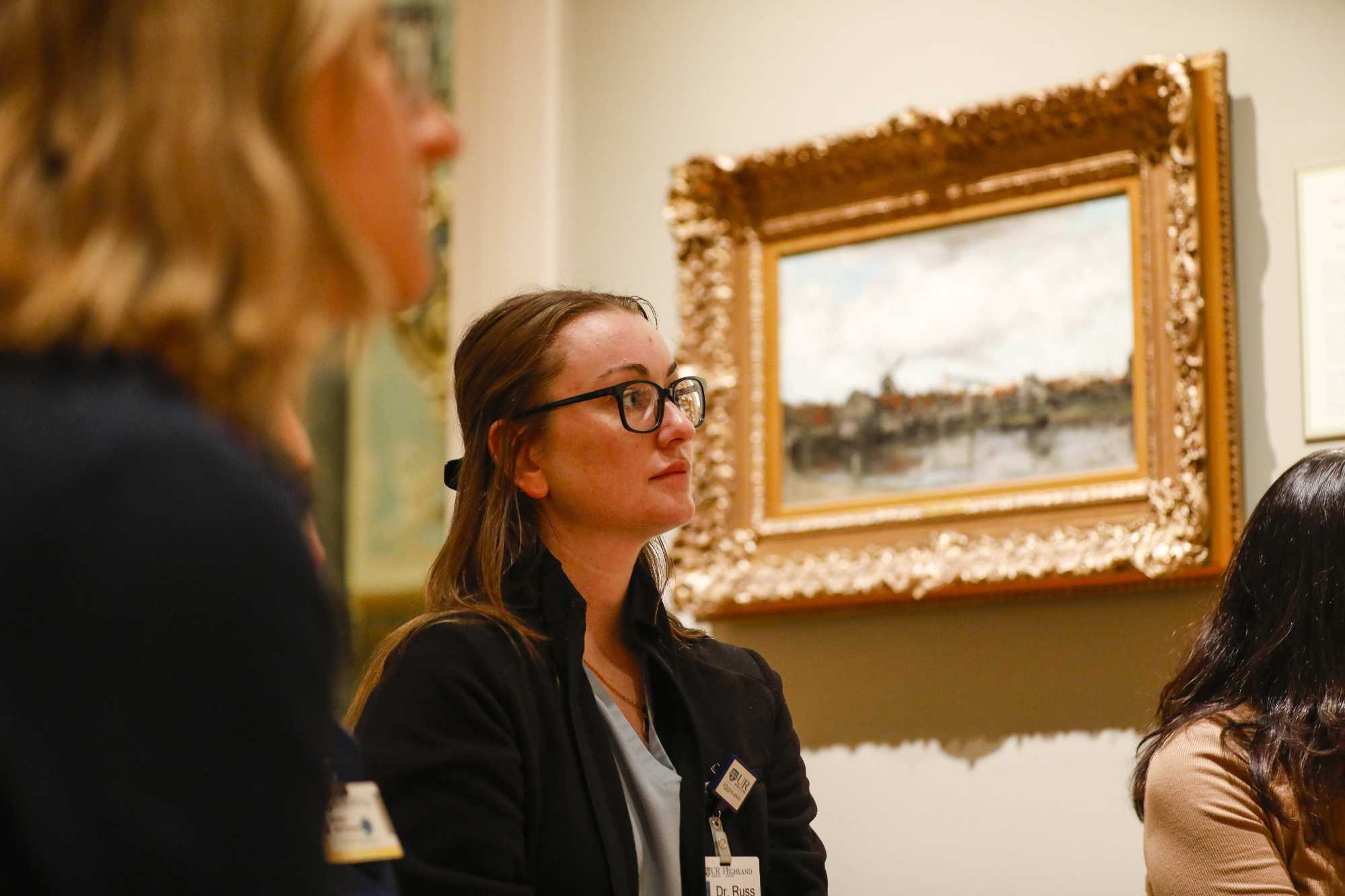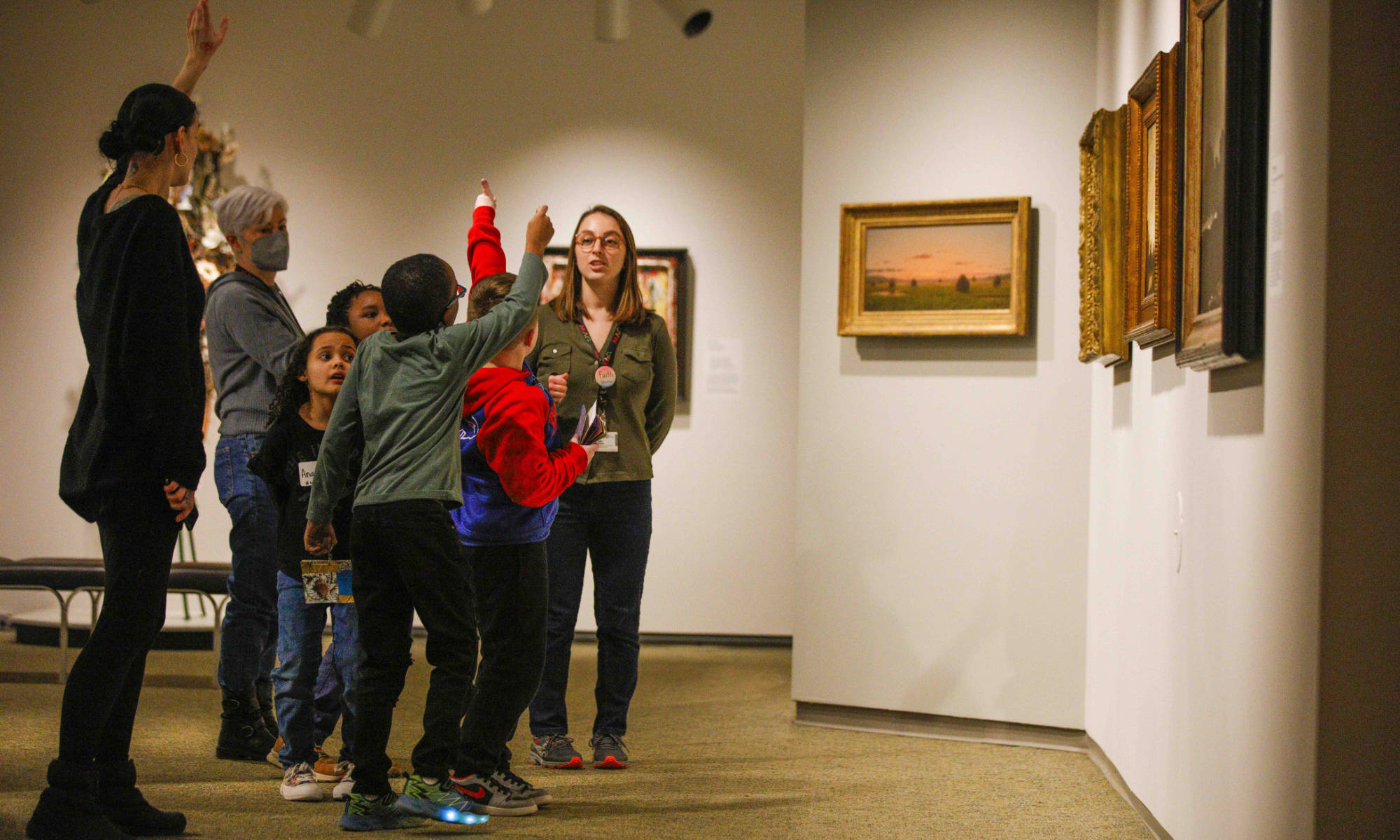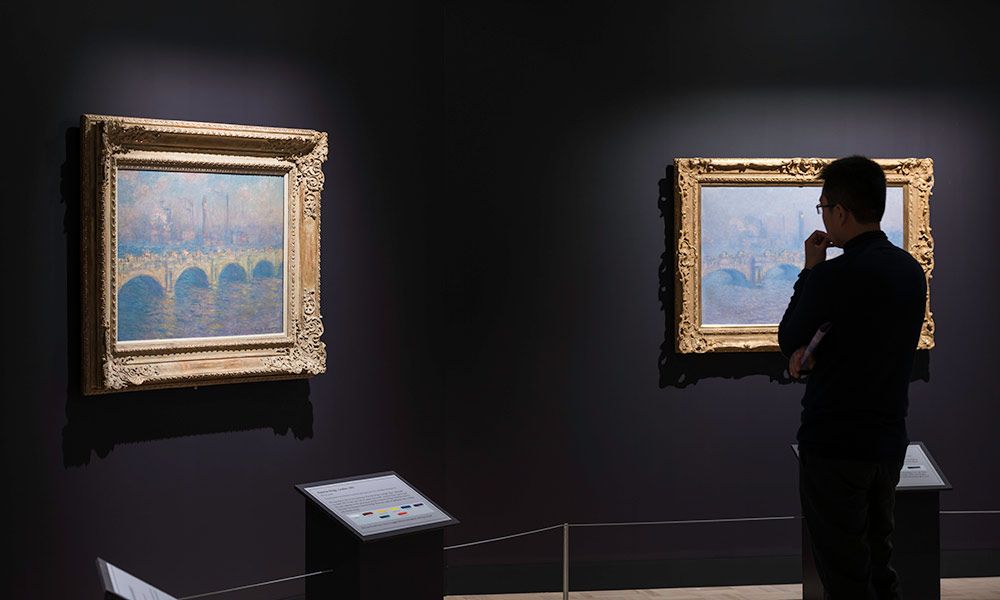Rochester’s Art of Observation program helps medical students and clinicians cultivate essential clinical skills.
After a day of seeing and treating patients, eight faculty-physicians from the University of Rochester Medical Center met at the University’s Memorial Art Gallery (MAG). They sat on folding stools before a painting of a woman and three children gathered around a table, on which the woman appeared to be cutting something. Pink sticky notes concealed the painting’s label with its title, artist, and other context.
“What do you see?” said Natercia Rodrigues ’19M (MS), an assistant professor at the School of Medicine and Dentistry, a family physician in the UR Medicine Primary Care network, and the group’s facilitator.
Rodrigues had just asked the first question of the Five Question Protocol (5QP), the lynchpin of the Art of Observation partnership between the University’s medical school, the School of Nursing, and the museum.
Designed to enhance observational skills for healthcare professionals, the sustained viewing and structured dialogue help participants unpack their assumptions, consider different perspectives, and avoid jumping to conclusions—among other cognitive biases—based on titles, dates, or locations. (That information is only revealed with the fourth question, when the sticky notes come off.)
BLENDING ART AND MEDICINE By observing our Memorial Art Gallery masterpieces, students and clinicians discover new angles to understanding patients and providing better care.
“I see a mom cutting food for her children,” one member of the group said. “Why doesn’t she use a cutting board on that nice wooden table?”
“She’s the maid,” another suggested.
“But the kids look like her,” someone countered.
“The room’s a bit barren and skimpy.”
“I don’t know if it’s skimpy, or just blurry. It actually looks lush, maybe lit by a fire.”
“‘Skimpy’ is definitely subjective,” said Rodrigues. “What else do you see?”
After a minute of silence, one responded: “The kids seem healthy.”
“The kids are hungry. Look how their hair is disheveled and they’re staring at the food she’s cutting. They’re starving.”
“Or did they just wake up from naps? Kids are always hungry.”
Each observation revealed a unique focus, perspective, and lived experience—which is exactly what doctors and nurses often bring to the exam room.
The fine art of patient care
The Five Question Protocol of the Art of Observation
What do you see?
Does this remind you of anything?
What’s the story? What is your evidence?
What information would confirm your hypotheses?
What did you observe about yourself?
“Everything about the 5QP is designed to build clinical skills,” says Susan Dodge-Peters Daiss, a senior associate at the Memorial Art Gallery and with the Department of Health Humanities and Bioethics. “This protocol evolved in response to a concern that physicians were jumping to conclusions. The Art of Observation program was designed to slow the viewer down, to actually focus on how they know what they know.”
Daiss cofounded Art and Observation at the University of Rochester in 2002 with Stephanie Brown Clark, now a professor emeritus, after they both read about a program at Yale University that focused on enhancing medical students’ observational skills through the study of detailed Victorian narrative pictures. Each educator brought unique interdisciplinary training to the partnership, with Daiss having experience in both art history and hospital-based pastoral care, and Clark having trained as a medical doctor before completing a doctorate in the humanities.
From the outset, Daiss and Clark have targeted the development of sound clinical practices beyond mere observational skills. These include listening, asking questions, acknowledging biases, and describing visual information, with the objective being to avoid errors in the often-complex process of clinical diagnosis.
“While we can’t be bias-free,” Daiss says, “we can be bias-aware.”

Students’ first taste of the program is the second day of medical school or early in the Accelerated Bachelor’s in Nursing Program. During sessions at the Memorial Art Gallery, they break into small groups, study a selection of narrative paintings, and review the 5QP with a trained facilitator who has knowledge of both art history and healthcare.
“One of our objectives for this program is learning to separate out observation from inference and assumption,” says Instructor of Clinical Nursing Kristina Santory ’06, ’14W (MS). “In a field that is so focused on physical assessments, lab values, and what to do next, this act of careful looking helps nursing students to pause and think: Are we seeing the whole picture?”
Santory often hears students ask, “‘We’re looking at the same painting; how can we see such different things?’ That’s the most surprising, but also most enriching, part of the activity.”
Taking time to see the bigger picture
Far from a “one and done” experience, Art of Observation lays the groundwork for other opportunities to engage with visual arts throughout medical school, from visits to anatomy labs to a course called Drawing to See: Drawing as a Tool to Build Observational Skills, taught by Daiss in partnership with the museum’s Creative Workshop art courses.
Piper Schneider ’27M (MD) says her experience with Art of Observation primed her to invoke the 5QP as she studied the live model in Drawing to See. Having students sit in a circle around the model, she adds, gave each one a distinct perspective that reinforced the lessons learned in the program. “The act of actually creating the work took me back to that thought process: Am I drawing something that I only think should be there, or that I can actually verify?” she says.
As Schneider prepares for clinical rotations as a medical student, she plans to “check in” with herself using queries that arose during Art of Observation. “Am I going down the right path? Am I filling in gaps with my own biased thoughts and feelings or am I truly listening to what the patient is sharing with me? The close study of art, and drawing technique, give me tools for how to approach patient conversation and diagnostic thinking.”

Rodrigues, Daiss’ former student and colleague, was likewise inspired by Art of Observation to develop the Continuing Medical Education session for Rochester faculty-physicians, called Cura te ipsum (Latin for “heal thyself,” and a play on the word curate).
“I think the 5QP perfectly parallels my experience within the doctor-patient relationship,” she says. “Having the time to appreciate details and draw parallels to what we’ve seen before gives me more space to pause and not rush to conclusions. Practicing that with art helps me be more mindful in practicing that with patients.”
For the fourth question of the 5QP—“What information would confirm your hypotheses?”—Rodrigues peeled off the sticky note to reveal the title, artist, and year: Bread and Butter, painted by Dutch artist Albert Neuhuys at the turn of the twentieth century. She added that George Eastman, one of Rochester’s most notable philanthropists, kept this painting on prominent display in his East Avenue mansion.
“He and his mother were very close,” said Rodrigues, referring to Eastman. “That might help us think about why he chose this for his home.” This prompted a flurry of comments.
“So it is a mother and children!”
“They look just like her.”
“How else,” Rodrigues asked the group, “does this context support or resolve uncertainties in your conjectures?”
“I feel better for this little family that they have access to butter!”
“And I feel better that she isn’t cutting into that table.”
“Unless it’s from IKEA,” someone added, eliciting laughter from the others.
This stage of the 5QP provides the critical background and research that, coupled with careful observation, leads to diagnostic accuracy. Likewise, the invitation to suggest multiple interpretations parallels the medical practice of differential diagnosis.
The final question (“What did you observe about yourself?”) encourages participants to reflect on their experience with the 5QP and what they learned about themselves individually as well as members of a group.
For William DiPasquale ’24M (MD), a resident in anesthesiology at the Medical Center, this has become an ongoing—and extremely valuable—process in learning how to take care of patients, especially those nearing the end of life.
“My first semester of medical school was challenging. We were studying intensely and working daily in the anatomy lab. I struggled to come to terms with the human reality of death and dying, and wasn’t sure how to process those emotions,” he explains. “I reached out to Susie [Daiss], and she invited me to re-engage in the Art of Observation process.”
Dipasquale adds, “The Memorial Art Gallery became a space where I could go, find inspiration, have moments of reflection, and process things I was learning and doing in class. Sharing these reflections helped me find a personal sense of peace, to harness my emotions in a positive way. Now I’m much more comfortable engaging with patients who are actively dying, largely thanks to this long-term reflective process. It’s already shaping my career.”





